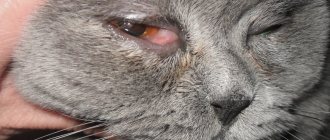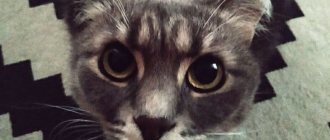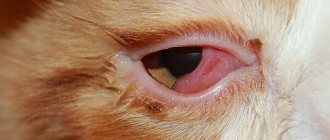Bright eyes in the night
- Fact:
The Holy Inquisition, which was active in medieval Europe, declared cats to be minions of the devil and witches. - Fact 2:
In the Middle Ages, thousands of cats were burned alive in bonfires and drowned in bags along with supposed witches. - Fact 3:
Behind the retina of these animals there is a special layer - tapetum, which contains a large percentage of photoluminescent pigment - Fact 4:
Maximally dilated pupils occupy almost the entire area of the iris, reflecting the light flux from the entire area of the fundus
The cat is an adroit hunter, and its vision works excellent even at night. But such a unique feature of cat eyes as the ability to glow in the dark did not always bring this animal only benefit.
The Holy Inquisition, which was active in medieval Europe, declared cats to be minions of the devil and witches. The basis for this was the activity of cats in the dark, as well as the vertical pupils and burning “hellfire in the night” eyes of these small predators. In addition, pagans revered cats, and early Christians tried in every possible way to destroy the roots of alien beliefs. During the Middle Ages, thousands of cats were burned alive in bonfires and drowned in sacks along with supposed witches. These brutal massacres continued until the 19th century, which marked the beginning of the Age of Enlightenment.
However, the barbaric attitude towards cats was characteristic only of those European countries where the Catholic Church dominated. Among the pagans of Africa and the Eurasian continent, the cat has always been revered as a sacred animal. In Rus', cats have been considered since ancient times as guardians of the hearth, and before the advent of Christianity they were associated with the names of the deities Rod, Veles and Mokosh. And the unique vision of these four-legged animals was explained by the need to travel between light and darkness - the worlds of the living and the dead, people and gods.
Russian Orthodox Christianity has retained this favor towards cats, despite their unusual habits. So, to this day, a cat is allowed to enter an Orthodox church and wander around it wherever it pleases. For example, dogs are prohibited from walking even in the area next to the church.
Cat eye glow effect
A cat walking in a dark room or along the street at night can cause a certain frightening sensation, a slight horror. Her eyes “glow” with a greenish, yellowish or even red light. Scientists have long learned the secret of this phenomenon. The “glow” of a cat’s eyes comes from a layer of blood vessels located on the eyeballs behind the retina. This shell is called tapetum. It has a reflective property, which creates a glowing effect.
Photons penetrate the retinal tissue and are captured by the tapetum, which reflects the rays. Nature did not give this property to cats in order to provide them with a mysterious, mystical appearance. It is thanks to the presence of the tapetum that animals are ideally oriented in the dark, since the retina of the eye receives significantly more light compared to the human eye under the same lighting conditions. To distinguish objects, fluffies need illumination six times less than for humans. Cats are predators, and they need keen vision at night for successful hunting. It also serves as protection against sudden attacks by enemies and allows you to detect danger in a timely manner.
The tapetum cannot glow; the effect is created only when photons from a natural or artificial light source hit the shell. If the cat is in complete darkness, there will be no mystical sparkle in the eyes. But it will still be able to navigate perfectly, since the animal is helped by its well-developed sense of smell, hearing, and touch.
Main reasons
All causes of the syndrome in the cat family can be divided into several groups:
- external causes (traumatic injuries and their consequences);
- ophthalmological causes (congenital and acquired structural changes of the eye, infectious pathologies);
- general infectious diseases;
- allergic reactions.
The diseases in each group are relatively homogeneous in origin, but differ in the nature of their course and the methods of treatment used.
Let's take a closer look at those that are most common.
External reasons
This type of hyperemia of the organ of vision occurs as a consequence of injury or exposure to various irritating substances on the cornea, namely:
- Foreign body getting into the eye. Debris or a foreign object stuck in a kitten's eye injures the delicate tissues, causing, in addition to redness, pain and lacrimation. Therefore, it is very important to remove it as soon as possible. In uncomplicated cases, the owner can cope with this on his own. But if the object has sharp edges or is located in the deep structures of the eye, then veterinary help is necessary. At the clinic, the pet will be given anesthesia, after which the foreign body will be surgically removed.
- Irritation of the cornea with soapy water when bathing or chemical agents when treating wool with insecticides. First aid consists of immediate rinsing with plenty of clean water. In the future, when carrying out various grooming procedures, it is necessary to protect the cat’s eyes from harmful influences.
- Hair hanging over the eyes of cats of long-haired breeds can prick and injure the cornea. If there is such a danger, you should always ensure that the long hairs around the eyes are neatly trimmed.
- Lens luxation. This condition can be of traumatic origin, but is sometimes a consequence of cataracts, uveitis or glaucoma. When the lens is dislocated, the iris has an abnormal appearance, and the displacement of the lens is visible to the naked eye. To reduce it, professional surgical assistance is required.
- Hyphema. With hyphema, blood accumulates in the anterior chamber. Causes may include injury or poor clotting. First of all, the cause of the hyphema is determined, then drug treatment is carried out with anti-inflammatory drugs and drugs that dilate the pupil.
- Proptosis is a partial or complete loss of the eyeball from the orbit as a result of traumatic impact. In this case, the disorder is treated surgically. If the damage is extensive, the eye may need to be removed.
Ophthalmic diseases as a cause of redness
- Blepharitis is an infectious or allergic inflammation of the eyelid. It is characterized by enlarged eyelids, discharge from the eyes, and itching. Once the cause of blepharitis is determined, medications are prescribed to eliminate it. In the case of an infectious nature of the disease, these are eye antibiotics and antifungal agents.
- Prolapse of the third eyelid gland (prolapse) is a disease in which the lacrimal gland loses its normal position, falls out of the conjunctival sac and becomes noticeable as a red formation in the corner of the eye. The prolapsed gland is removed surgically, but sometimes doctors decide to do without surgery. It is adjusted, returned to its normal position and fixed to prevent relapse.
- Conjunctivitis is inflammation of the conjunctiva. The disease may be infectious or allergic in origin. Characterized by thickened conjunctiva and lacrimation. The main method of treatment is the use of antibacterial or other drugs in accordance with the nature of the pathogen.
- Tumor of the eye and ocular structures. It can be localized in the eye or in the tissues surrounding the eye. Symptoms of the disease depend on which tissues and structures are affected. Treatment is usually surgical. If necessary, radiotherapy or chemotherapy is prescribed.
- A corneal ulcer is a violation of its surface layer. The cause of the disease may be infectious. The disease is accompanied by pain, photophobia and redness of the cornea. For treatment, local antibiotic therapy is used.
- Keratoconjunctivitis sicca most often affects older cats. Their lacrimal apparatus does not produce a sufficient amount of tear fluid, as a result of which the cornea dries out, and there is a burning sensation and irritation of the eyes in bright light. You can alleviate the animal’s condition by instilling an “artificial tear” drug to soften the cornea and replenish moisture deficiency.
- Glaucoma is the destruction of eye structures under the influence of high intraocular pressure. Accompanied by dilated pupils and clouding of the cornea. Older animals are more susceptible to pathology. In the severe stage, atrophy of the optic nerve occurs and complete blindness occurs. Symptomatic treatment is carried out by instilling drugs that reduce intraocular pressure. This allows you to slow down the destructive processes of the organ of vision.
Common infectious diseases of the body
Redness of the eyes is a symptom of some common infectious diseases. Here are some of them:
- Mycoplasmosis is a serious infectious disease, a complication of which is pneumonia. In addition to conjunctival tissue, the genitals, kidneys, and joints can be affected. If a cat has signs of a cold for a long time (cough, inflammation of the conjunctiva, nasal discharge, fever) and his eyes are red, then there is reason to assume that he has mycoplasmosis.
- Chlamydia is a chronic disease that affects the eyes, upper respiratory tract, and gastrointestinal tract. Pathogens are intracellular parasites that are resistant to any type of treatment. Red eye syndrome is caused by its conjunctival form, which can result in complete blindness.
- Calcivirosis is a viral disease, the target of which is the conjunctiva, mucous membranes of the nose and mouth, and joints. Transmitted by direct contact. The mortality rate from calcivirus among cats is very high. The main method of treatment is the prescription of local antiviral drugs and antibacterial agents (if a bacterial infection is attached).
Allergic reactions
Eye allergies to various substances (unusual food, medications, plants, household chemicals) have symptoms of allergic conjunctivitis. They are as follows: severe hyperemia of the conjunctiva and surrounding tissues, lacrimation, pain in the eyes, inability to look in bright light.
Allergic rhinitis often occurs when the animal cannot breathe through its nose, smell, and loses interest in food. Eye allergies can be expressed as allergic blepharitis (inflammation of the eyelid mucosa), allergic uveitis (inflammation of the iris). The main method of treatment is to identify the allergen, urgently remove it from the animal, and prescribe antihistamines that relieve painful symptoms.
The phenomenon of eye glow in other representatives of the fauna
Many consider the glow of the eyes to be the prerogative of cats, their individual phenomenon. But this is a misconception. The effect is observed in all representatives of the fauna, whose visual organs are equipped with a tapetum layer. It is available at:
- wild, large felines;
- dogs;
- deer and horses;
- rabbits; rats and mice;
- spiders;
- crustaceans and fish.
The difference between the glow of cat's eyes is expressiveness and effectiveness, which makes it more noticeable and attractive. In addition, we see these animals in the dark most often, which became the reason for attributing this phenomenon to beloved pets.
Human eyes do not have a tapetum, they do not have a reflective effect, and do not glow in the dark. After all, according to the laws of nature, people stay awake during daylight hours. This effect is gifted only to predators and animals that must escape from these night hunters.
First aid and prevention
Why do my cats always have red eyes? The reason is different in each specific case. The syndrome may be a consequence of violation of the rules for caring for the animal, or it may be a symptom of a serious illness. Therefore, if the redness does not go away for a long time, you should not delay a visit to the veterinarian. Only he can make a high-quality diagnosis, assess the pet’s condition and determine further treatment tactics.
If the owner does not have the opportunity to immediately go to the clinic, you can use first aid techniques for ophthalmological problems. They will help alleviate the pet’s condition somewhat and, in some cases, have a therapeutic effect.
- It is necessary to put a protective collar on the neck of a cat or kitten, which will prevent them from touching their eyes with their paws, and therefore prevent the risk of secondary infection.
- You should regularly remove discharge from the eyes and rinse them with cotton pads soaked in warm boiled water or a strong solution of tea leaves.
- To reduce the inflammatory reaction, you can instill antiseptic eye drops or an “artificial tear” drug.
- Hair hanging over the eyes should be trimmed more often so that it does not injure the cornea.
If you ignore a symptom such as redness of the eye sclera, you may miss the onset of a serious illness in your cat. It’s better to play it safe and take your pet to the veterinarian as soon as possible for an examination and consultation, so that you don’t have to regret the lost time later.
Interesting information about the features of cat vision
For the most part, cats' eyes glow green or yellow. The intensity and shade are determined by the amount of zinc and riboflavin in the tapetum layer. There are also rare glow colors. For example, the eyes of Siamese cats emit red, crimson light in the dark. A decrease in the brightness of the effect comes with age. In older cats, the density of the lens increases, reducing the ability to reflect photons. The cause of dim light in young cats may be glaucoma or cataracts.
Cat eyes have several unique features:
- The visual acuity of these pets is almost 10 times higher than that of humans.
- The viewing angle of cats is 20° greater than that of humans. Our radius is 180°, for pets it is 200°.
- In terms of color perception, cat eyes are inferior to human eyes. Animals distinguish only a few shades. They see well the tones of green, black, blue, white, and gray. They do not perceive the remaining sectors of the color spectrum. It was previously believed that cats see the world in black and white, but recent research disproves this claim. There is no need to think that limited color vision causes inconvenience for cats. Pets don’t worry about the fact that they can’t distinguish between yellow and red, they don’t need it.
The quality of vision of these animals can be appreciated by two facts. A cat can see objects at a distance of half a kilometer or more. It can clearly see the smallest details of an object at a distance of 60 meters. The most vigilant person does not have such qualities.
There are some differences in the perception of static and moving objects. Animals can better see an object that is moving. Moreover, they see objects moving horizontally most clearly. The cat sees vertically moving objects worse.
It is known that dogs see nearby objects better, but their vigilance decreases when they move away. Cats' vision organs are structured differently. These pets are farsighted. They have difficulty seeing objects located nearby, but are excellent at viewing distant targets.
How to explain to children
If your interest in this topic was sparked by a child's question and you are looking for an easy way to teach about the structure of a cat's eyes, the video below will help you:
Is your baby still very young, but very interested in the question asked? Well, fairy tales will help you. Usually, in order not to mislead the child, they talk about a cat that got lost in the dark. The plaintive call of the animal was heard by the moon or the lunar sorceress. Taking pity on the purr, she endowed the cat’s eyes with a special property: collecting light in the darkness of the night. The cat returned home and everyone lived happily ever after.
As you can see, this fantastic story tells about the real reason for what is happening, but in a soft and understandable form for a child. It’s up to you to decide whether to use real data or imagine something unnatural, but keep in mind that most strong beliefs are formed precisely during the period of whys.
How to explain to children.
The owners of the furry creature and at the same time parents may notice their child’s tension in the evenings at certain times. For example, a baby absolutely does not want to let a cat into his room at night. Or he tries to avoid contact with his pet altogether. There can be many reasons and you need to deal with them immediately. And a fairly common cause is the glow of the animal’s eyes in the dark, which can frighten the baby.
Cats and children are best friends.
There are different ways to explain to children the reason for glowing cat eyes. Believing families can explain this phenomenon with a legend from their religion. For example, Christians can talk about the Lord who endowed a cat with his light so that it would drive away darkness from its owners.
If the parent does not want to mislead the child and wants to explain everything scientifically, a question arises. How can this be done so as not to break the baby’s brain, but so that he understands everything? And it turns out it's quite easy.
You can show the child a mirror and explain that in the eyes of a cat there is the same small mirror that reflects light, which is why such a phenomenon as the glow of the eyes appears.











